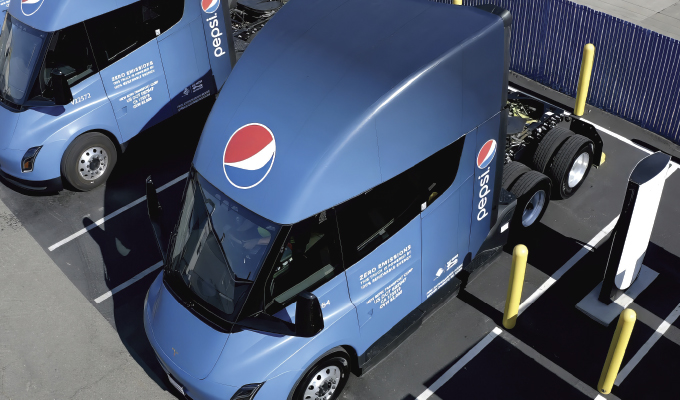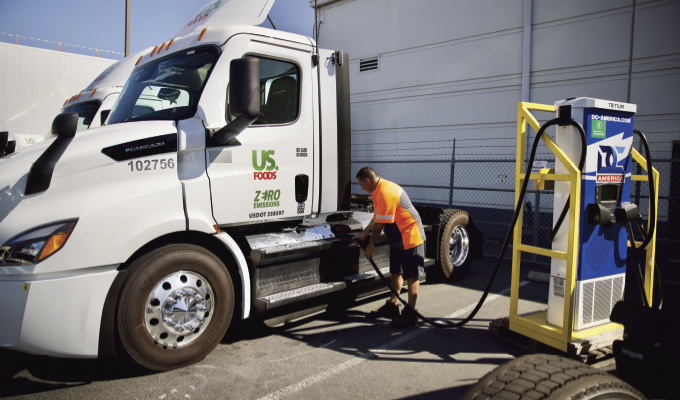Recently, Mike Roeth, Executive Director of the North American Council for Freight Efficiency (NACFE), spoke with Charlotte Argue, Senior Manager, Sustainable Mobility at GEOTAB, on the state of commercial adoption of electric vehicles (EVs), freight efficiency and electrification trends. With more than 35 years in the commercial vehicle industry, Roeth has seen practices evolve and has been instrumental in bringing green truck collaborative opportunities to the real-world at scale.
Q: WHAT EXCITING INNOVATIONS ARE YOU SEEING IN TRUCKING?
Mike Roeth: It is hard to point to just one thing when talking about innovation in the trucking industry today. The industry is working on a variety of technology solutions to get us to a zero-emission freight future. This is something we should be proud of as we are recognizing our responsibility to operate in a more sustainable manner.
Q: HOW DO YOU SEE THE ROLE OF BATTERY ELECTRIC VEHICLES (BEVS) EVOLVING FOR FLEETS?
Roeth: Today BEVs are already being successfully deployed by fleets in a wide variety of applications. I expect to see more fleets move from having one or two BEVs to having 10, 15, 20 or more. As battery weight comes down, range increases and there starts to be a better opportunity for charging at locations other than fleet depots, I expect we will see more fleets deploying BEVs in larger and larger numbers.
Q: BEYOND BEVS, WHAT OTHER CLEAN POWERTRAIN TECHNOLOGIES DO YOU BELIEVE HOLD PROMISE FOR THE TRUCKING INDUSTRY?
Roeth: We are in a time that NACFE has dubbed the “messy middle.” During this time fleets have access to a variety of powertrain options in addition to BEVs, including fuel cell electric, renewable diesel, hydrogen, hydrogen internal combustion, renewable natural gas, and hybrids. The key is to match the right powertrain to the right application. There is no one-size-fits-all solution as we move to a cleaner transportation future.
Q: WHAT IS A COMMON MISUNDERSTANDING ABOUT BEVS AND THEIR CAPABILITIES?
Roeth: People erroneously believe that BEVs always need to be charged to 100 percent. The reality is that BEVs can still operate effectively at reduced state of charge levels. Opportunity charging allows a fleet to increase the battery’s state of charge so a truck can finish its route without needing to be fully recharged.

Q: HOW DO YOU RESPOND TO THE CONCERNS OF THOSE WHO BELIEVE BEVS ARE NOT YET A VIABLE OPTION FOR ALL TRUCKING APPLICATIONS?
Roeth: To some extent they are correct. Today BEVs are proving to be a viable option for terminal tractors, vans and step vans, medium-duty box trucks and Class 8 trucks in regional haul applications. People mistakenly believe that all trucking is long haul but that is not true.
In addition, significant improvements are being made in BEVs every day. In Run on Less – Electric DEPOT, the Tesla Semi saw ranges of 410 miles on a single charge and completed 1,076 miles in a 24-hour period. NACFE is planning Run on Less – Messy Middle in 2025 and it will focus on the various powertrain options, including BEVs, in the long-haul segment of trucking.
Q: IN WHAT WAYS CAN OEMS, FLEETS, AND REGULATORY BODIES COLLABORATE TO ACCELERATE THE ADOPTION OF BEVS?
Roeth: There is some complexity when switching to BEVs so that the right vehicle is chosen for the application and to ensure that the proper infrastructure is in place when the vehicles arrive. Fleets and OEMs can work closely with utility providers and others so that the infrastructure is in place when needed. In addition, fleets and OEMs can share real-world information with regulatory agencies so that regulations are not onerous but help move the industry closer to decarbonizing.
Q: HOW DO YOU ENVISION THE TRUCKING INDUSTRY’S LANDSCAPE IN THE NEXT FIVE TO 10 YEARS, IN RELATION TO BEVS AND OTHER CLEAN TECHNOLOGIES?
Roeth: More fleets will be making investments in BEVs and other clean technologies. We will continue to see fleets operating vehicles with a variety of powertrains as they match powertrains to duty cycles to optimize efficiency.
FOR MORE INFORMATION
The North American Council for Freight Efficiency (NACFE) works to drive the development and adoption of efficiency enhancing, environmentally beneficial, and cost-effective technologies, services, and operational practices in the movement of goods across North America. NACFE provides independent, unbiased research, including Confidence Reports on available technologies and Guidance Reports on emerging ones, which highlight the benefits and consequences of each, and deliver decision-making tools for fleets, manufacturers, and others. To learn more, visit www.nacfe.org.




